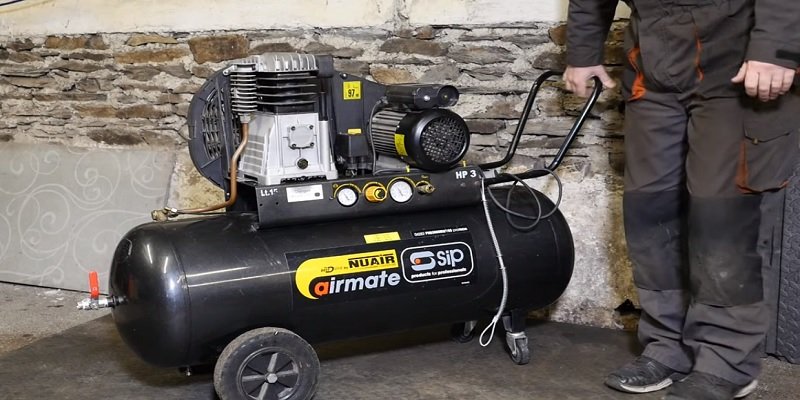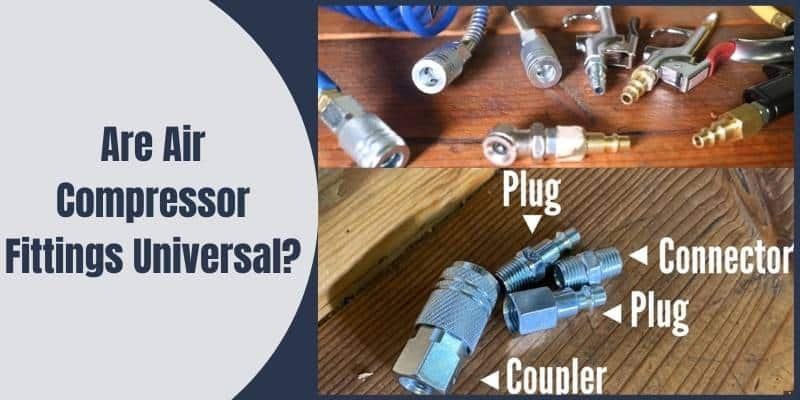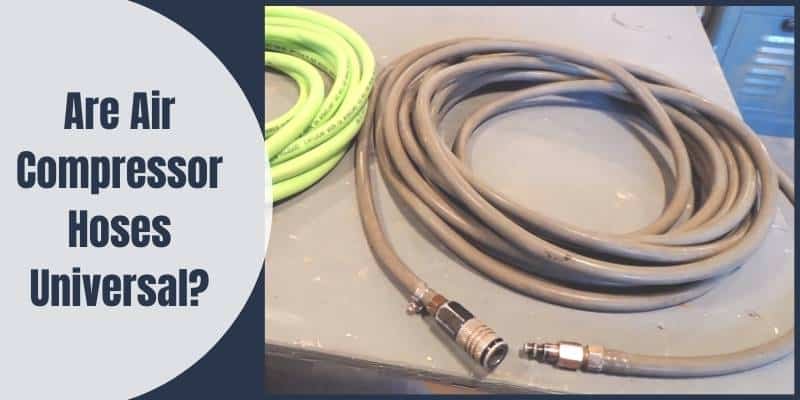Disclosure: This post contains affiliate links and I will be compensated if you make a purchase after clicking through my links. Learn More
Air compressors are essential tools for various tasks, from inflating tires to powering pneumatic tools. If you’re a DIY enthusiast or a professional who uses air compressors regularly, you might have wondered, “Can you lay an air compressor on its side?” This seemingly simple question can have important implications for the functionality and lifespan of your equipment.
In this article, we’ll provide you with a comprehensive guide that explores the pros and cons of laying an air compressor on its side.

Understanding Air Compressors
When it comes to understanding air compressors, there are a few key things you need to know. Air compressors are used to power a variety of tools and equipment, from nail guns to paint sprayers to sanders and more. They work by compressing air and storing it in a tank, which can then be used to power the tool or equipment.
One important thing to keep in mind is that air compressors come in different sizes and with different features. Some are designed for heavy-duty use, while others are more lightweight and portable. It’s important to choose the right air compressor for your needs, based on the type of work you’ll be doing and how often you’ll be using it.
Another thing to consider is how the air compressor will be stored and transported. While some air compressors are designed to be used in a stationary location, others are more portable and can be easily moved from place to place. If you’ll be transporting your air compressor frequently, it’s important to choose one that is lightweight and easy to move.
Can You Lay an Air Compressor on Its Side?
Yes, you can lay an air compressor on its side, but it’s crucial to consider certain factors before doing so. Modern air compressors are designed to be more versatile, allowing you to position them horizontally or vertically.
However, there are some important considerations to keep in mind:
Ensuring Proper Lubrication
When you lay an air compressor on its side, you need to ensure that the lubrication system is not compromised. Lubrication is essential for the smooth operation of the compressor’s internal components. Some compressors come with specialized lubrication systems that allow them to operate in any position. Before laying your compressor on its side, consult the manufacturer’s guidelines to ensure that lubrication will not be an issue.
Oil Leakage
Certain air compressors use oil for lubrication, and laying them on their side could lead to oil leakage. If your compressor uses oil, it’s recommended to drain the oil before repositioning it. Additionally, you should let the compressor sit upright for a while before using it again. This will allow the oil to settle back to its proper place and minimize the risk of leakage.
Intake and Ventilation
The position of the air intake and ventilation ports is crucial when laying an air compressor on its side. Blocking these ports can lead to overheating and reduced performance. Make sure that the intake and ventilation areas remain unobstructed to ensure proper airflow.
Potential Vibrations
Some air compressors can generate significant vibrations during operation. When positioning the compressor on its side, consider placing it on a stable surface to minimize vibrations. Excessive vibrations can not only affect the compressor’s efficiency but also lead to premature wear and tear.
Best Practices for Laying an Air Compressor on Its Side
- Check the manufacturer’s guidelines: Always refer to the user manual or guidelines provided by the manufacturer regarding the allowable positions for your specific air compressor model.
- Use a stable surface: If you decide to lay the compressor on its side, make sure it’s on a level and stable surface to prevent vibrations.
- Allow for proper airflow: Ensure that the air intake and ventilation ports are not blocked to maintain optimal cooling.
Impact on Compressor Performance
Oil Lubricated Compressors
If you lay an oil-lubricated air compressor on its side, the oil inside the compressor can leak out and cause damage to the compressor’s internal components. The oil may also mix with the air and cause contamination of the compressed air, which can impact the quality of the output.
Furthermore, when the compressor is laid on its side, the oil may not reach all the necessary components, leading to inadequate lubrication. This can cause increased wear and tear on the compressor’s components, leading to reduced performance and longevity.
Oil-Free Compressors
Oil-free compressors are designed to operate in any orientation, including on their side. These compressors use special materials and coatings to lubricate the internal components, eliminating the need for oil.
Therefore, laying an oil-free compressor on its side will not impact its performance. However, it is still important to ensure that the compressor is properly secured and not subjected to excessive vibration or movement, which can cause damage to the compressor’s components.
In summary, if you have an oil-lubricated air compressor, it is not recommended to lay it on its side as it can cause damage to the compressor’s internal components and impact the quality of the compressed air. On the other hand, oil-free compressors can be laid on their side without any impact on their performance.
How Long Can You Lay an Air Compressor on Its Side
When it comes to laying an air compressor on its side, it’s important to consider the type of compressor you have. Some compressors are designed to be laid on their side, while others are not.
If your compressor is designed to be laid on its side, then you can do so for as long as you need to. However, if your compressor is not designed to be laid on its side, then you should avoid doing so.
Laying an air compressor on its side can cause oil to leak into the compressor’s cylinders, which can cause damage to the compressor’s internal components. Additionally, if the compressor is not designed to be laid on its side, then the compressor’s oil pump may not be able to properly lubricate the compressor’s internal components, which can also cause damage over time.
If you need to transport your compressor, it’s best to keep it upright and secure it properly to prevent it from tipping over. If you need to store your compressor for an extended period of time, it’s best to keep it upright and drain the oil to prevent any potential damage.
In summary, if your air compressor is designed to be laid on its side, then you can do so for as long as you need to. However, if it’s not designed to be laid on its side, then you should avoid doing so to prevent potential damage to the compressor’s internal components.
Safety Precautions
When handling an air compressor, it is important to take safety precautions to prevent accidents and injuries. Here are some safety tips to keep in mind:
- Always read the manufacturer’s instructions before using the air compressor. Follow all safety guidelines and warnings provided by the manufacturer.
- Make sure the air compressor is placed on a stable and level surface. Do not place it on uneven ground or on a surface that is prone to vibrations.
- Never lay an air compressor on its side while it is running. This can cause oil to leak into the compressor’s cylinders, resulting in damage to the compressor’s internal components.
- If you need to transport the air compressor, make sure it is properly secured in the vehicle. Use straps or other restraints to prevent it from moving around during transport.
- Wear appropriate personal protective equipment (PPE) when using the air compressor. This may include safety glasses, earplugs or earmuffs, and gloves.
- Do not exceed the maximum pressure rating of the air compressor. This can cause the compressor to overheat and potentially explode.
- Do not use the air compressor in wet or damp conditions unless it is specifically designed for such use. Moisture can damage the compressor’s internal components and cause it to malfunction.
- Always turn off the air compressor and unplug it from the power source before performing any maintenance or repairs.
By following these safety precautions, you can help ensure that your air compressor operates safely and efficiently.
Maintenance Tips When Laying Compressor on Its Side
When laying your air compressor on its side, it is important to take certain maintenance precautions to ensure that it continues to function properly. Here are some tips to follow:
- Drain the oil: Before laying the compressor on its side, make sure to drain the oil completely. This will prevent any oil from leaking into the compressor’s cylinders and causing damage.
- Check the air filter: Make sure that the air filter is clean and free of debris before laying the compressor on its side. This will ensure that the compressor gets the proper airflow it needs to function correctly.
- Secure the compressor: When laying the compressor on its side, make sure that it is secure and won’t tip over. This will prevent any damage to the compressor and ensure that it continues to function properly.
- Use caution when restarting: When restarting the compressor after laying it on its side, use caution. Make sure that the oil has been refilled and that the compressor is properly secured before starting it up.
By following these maintenance tips, you can ensure that your air compressor continues to function properly even when laid on its side.
Common Misconceptions
When it comes to using an air compressor, there are many misconceptions that people have. In this section, we will address some of the most common misconceptions that people have about laying an air compressor on its side.
One common misconception is that laying an air compressor on its side will damage the motor. However, this is not necessarily true. While it is true that some air compressors may be damaged if they are laid on their side, this is not always the case. In fact, many air compressors are designed to be used in any position, including on their side.
Another misconception is that laying an air compressor on its side will cause oil to leak out of the crankcase. While it is true that some air compressors may experience oil leaks if they are laid on their side, this is not always the case. Many air compressors have been designed to prevent oil leaks, even when they are used in any position.
Finally, some people believe that laying an air compressor on its side will cause it to overheat. While it is true that some air compressors may overheat if they are used in certain positions, this is not always the case. Many air compressors are designed to operate at a wide range of temperatures, including when they are used on their side.
Overall, it is important to understand that not all air compressors are created equal. While some may be damaged if they are laid on their side, others are designed to be used in any position. If you are unsure whether your air compressor can be used on its side, it is important to consult the manufacturer’s instructions or contact a professional for advice.
Alternatives to Laying an Air Compressor on Its Side
If you’re wondering whether you can lay an air compressor on its side, the answer is generally no. However, there are alternatives you can consider to avoid the risks associated with laying an air compressor on its side.
Vertical Storage
One alternative to laying an air compressor on its side is to store it vertically. This is the recommended way to store most air compressors, as it reduces the risk of oil leaks and other damage to the compressor. Many air compressors come with a vertical storage option, so if you’re unsure whether your compressor can be stored vertically, check the manufacturer’s instructions.
Horizontal Storage
If you need to store your air compressor horizontally, there are some precautions you can take to minimize the risk of damage. First, make sure the compressor is empty of air and oil. This will reduce the risk of leaks and spills. Second, place the compressor on a flat, stable surface. This will help prevent the compressor from tipping over or shifting during storage.
Wall Mounting
Another option to consider is wall mounting your air compressor. This is a great option if you have limited floor space or want to keep your compressor out of the way. Wall mounting also reduces the risk of damage to the compressor, as it keeps it off the ground and away from other equipment. Many air compressors come with wall mounting brackets or kits, so check the manufacturer’s instructions to see if this is an option for your compressor.
Overall, there are several alternatives to laying an air compressor on its side that you can consider. By following these tips, you can help ensure your compressor stays in good condition and lasts for years to come.
FAQs
Can laying an air compressor on its side damage the motor?
Laying an air compressor on its side can potentially damage the motor if proper precautions are not taken. It’s important to follow the manufacturer’s guidelines and consider factors like lubrication, ventilation, and stability.
Can I transport an air compressor on its side?
Transporting an air compressor on its side is generally not recommended, especially if it’s a large or heavy unit. Transporting it in an upright position is safer to prevent potential damage during transit.
Are there compressors specifically designed for horizontal positioning?
Yes, some air compressors are designed to be used in various positions, including horizontal placement. These models typically have features that ensure proper lubrication and ventilation in different orientations.
Can I use an extension cord if I need to position the compressor far from a power outlet?
Using an extension cord is possible, but it’s essential to choose the right cord with sufficient power capacity. Check the compressor’s power requirements and the extension cord’s specifications to avoid voltage drop and potential hazards.
What should I do if my compressor has an oil leak after being laid on its side?
If you notice an oil leak after laying your compressor on its side, it’s recommended to drain the oil, allow the compressor to sit upright for a while, and then refill it with the appropriate amount of oil as per the manufacturer’s instructions.
Can I lay any type of air compressor on its side?
Not all air compressors are suitable for horizontal positioning. Smaller portable models and those designed for versatility are more likely to be safe for side placement. Always refer to the manufacturer’s guidelines to determine the allowable positions for your specific compressor.
Conclusion
In conclusion, the answer to the question “Can you lay an air compressor on its side?” is yes, but with important caveats. While some air compressors are designed to be versatile and can be positioned horizontally, it’s crucial to follow the manufacturer’s guidelines to ensure proper lubrication, prevent oil leakage, maintain ventilation, and minimize vibrations. By understanding the potential effects of laying an air compressor on its side and adhering to best practices, you can prolong the life of your equipment and ensure optimal performance.
Remember, before making any decisions regarding the positioning of your air compressor, always refer to the user manual and guidelines provided by the manufacturer. This will help you make informed choices that contribute to the longevity and efficiency of your valuable equipment.


